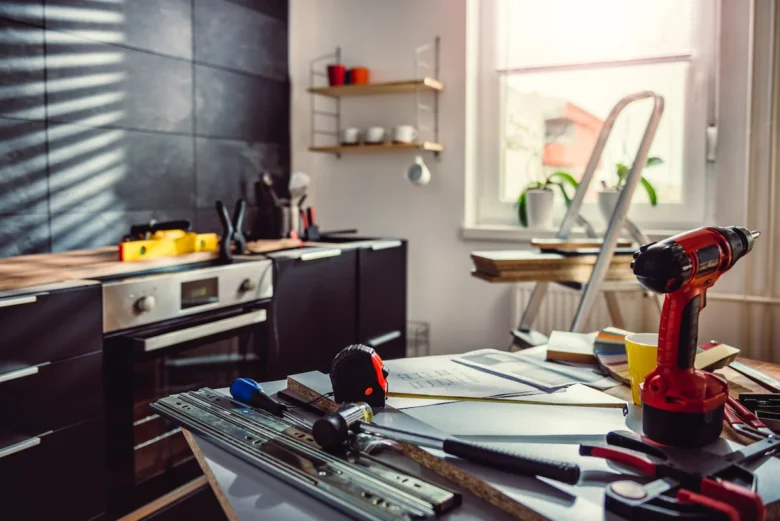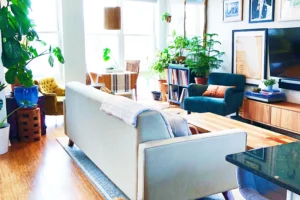DIY home improvement projects can be fun for novices and are a great way to improve your living space while learning new skills. Not only will these projects make you feel good, but but they can also increase the value and usefulness of your home. If you’ve never done anything like this, it’s best to start with a small job you can handle. This will help you gain confidence and skills. Here’s a list of easy, impressive DIY projects that will improve your home, perfect for beginners.
Painting space
Painting a room is one of the easiest and most fun things you can do yourself. If you choose the right color, a new coat of paint can bring a room back to life and make it feel brighter, larger, or cozier. Start by choosing a color that matches your furniture and the atmosphere you want to create. Have paint, rollers, brushes, painter’s tape, and rags ready. Prepare the room by cleaning the walls, repairing cracks or holes, and taping the edges. Painting your house can be a fun weekend job and can make a big difference in its appearance.
Build a floating shelf
Floating shelves can make any room look better and be more useful at the same time. You can place books, decorations or stored items in it without taking up space. Most hardware stores sell pre-made floating shelves, complete with hardware and instructions for installing them. To ensure that your shelves are securely attached to the wall, you’ll need a drill, a spirit level, and maybe even a stud finder. This job can usually be completed in an afternoon and will give your space a quick and satisfying refresh.
Buy new cabinet hardware
You can easily give your kitchen or bathroom a new look by replacing old, worn-out knobs or handles with new, stylish ones. This small change can make a big difference in the look of a room. All you need are new tools, a screwdriver, and maybe a drill if you need to make new holes. It’s a simple job, but can make a big difference in the appearance of your home. It’s also a great way to get started for people new to DIY home renovations.
Installing a gallery wall
Gallery walls are a unique way to add color and personality to an otherwise empty space. Start by choosing from a range of frames and artwork that suits your style. Start by placing your arrangement on the floor and planning where you will hang it. Use a spirit level and tape measure to ensure even spacing. Only use picture hanging strips or small nails to minimize damage to the wall. You can get creative with this project and it’s easy to change it over time.
Replace lamps
Replacing old light bulbs with new ones is a great way to make your home look more modern. Before performing any other operations, be sure to turn off the power to the lamp at the circuit switch. Most people just starting out can replace a light bulb by carefully following the manufacturer’s instructions and using simple tools such as a screwdriver and wire strippers. This job not only makes your home look better but also makes your lighting work better.
Apply new sealant in the bathroom
Over time, bathroom caulk can mold or flake off, leaving the room looking dirty. Sealing is easy and cheap to do yourself. To get a new, clean look, remove the old caulk, clean the area thoroughly, and then apply the new caulk. This not only makes your bathroom look better but also ensures that your sink, bath, and shower are properly sealed to prevent water from entering.
Lawn maintenance and gardening
Adding some landscaping or carving out a garden can make your home look better from the street. You can make your outdoor space more inviting and interesting by planting flowers, shrubs, or even a small vegetable garden. A shovel, trowel, and gardening gloves are some of the things you will need for basic gardening. It’s very satisfying to watch your plants grow and bloom while you’re at it.
DIY storage solutions for organization
Creating your own storage solutions can help you clear out clutter and keep your home organized. You don’t need many tools or supplies to make a simple closet organizer, storage box or shelf. There are many step-by-step guides online that can help new DIYers come up with a good storage solution. This type of work not only makes your home more useful, but it also teaches you useful skills, such as how to work with wood and put things together.
Conclusion
For starters, DIY home improvement projects can include everything from painting and shelving to gardening and finding ways to store things. You can build confidence and gain experience by starting with small, manageable jobs. This prepares you for bigger, more difficult tasks in the future. With any job, it’s important to be patient, plan ahead and keep safety in mind. As you complete each job, your living space will not only look better, but you will also be proud of what you have done. Remember, every good DIYer started as a beginner. Every job you complete brings you one step closer to becoming a home improvement expert.
FAQs
1. What is the most important thing I need for a DIY home improvement project?
The basic tools for most first projects should include a hammer, flat-head and Phillips screwdriver, a spirit level, a tape measure, a utility knife, pliers, an adjustable wrench, a drill with several bits, and safety equipment such as goggles and gloves.
2. How do I choose the right type of paint for my job?
Choose a painting based on the purpose of the room and the surface you want to paint. To give kitchens and bathrooms a waterproof finish, use semi-gloss or high-gloss paint. For a softer look, use flat or white finishes in living rooms and bedrooms. Make sure you choose good paint, it covers better and lasts longer.
3. Can I do electrical work even if I’m not very good at it?
Electrical work can be dangerous, so it is best left to experts or trained personnel. For example, a beginner can replace the cap on an electrical outlet or lighting fixture. But make sure you turn off the power at the circuit breaker and follow the instructions carefully. If you’re not sure, hire an electrician.
4. What is the best way to hang a shelf directly?
Make sure your planks are straight and level and measure carefully before drilling holes. Using a stud finder, you can attach the shelves to wall studs for extra support, especially for heavy items. To ensure accuracy, you can also mark the drill points with a pencil before starting.
5. How do you prepare a room for painting?
First, move the furniture away from the wall and cover it with drop cloths or plastic sheeting. Protective window and door frames, moldings, and doors are secured with masking tape. Clean the walls with a mild soap and use plaster to patch any holes or cracks. The best surface preparation is to sand the surface smooth before painting.
6. Do I need to prime the walls before painting?
If you want to paint over a dark color, cover stains, or paint on new walls, you will need to apply a primer first. Primer provides even coverage of the paint, better adhesion, and reveals the true color of the paint.



